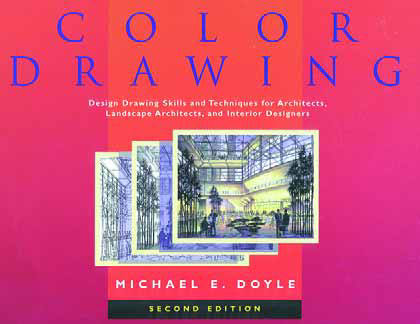Rendering Creativity

Among the most useful and influential books I’ve read in my career as a landscape architect and watershape designer is Color Drawing by Michael E. Doyle (John Wiley & Sons, 2nd edition, 1999).
I went in to landscape architecture mainly because I wanted to learn to do beautiful hand-drawn renderings and presentations. I’d started drafting in 7th grade, always really enjoyed the process and, even though I’m far from a great natural talent, have always seen drawing as a source of tremendous fun and satisfaction.
When I started studying landscape architecture in college, grades in my some of my design classes were based disproportionately (I thought then) on the student’s ability to represent ideas on paper. Even though I enjoyed drawing, I thought the emphasis on it was outrageous because, after all, good design is good design no matter how it’s represented.
Before long, I ran into an instructor who tested my beliefs. He explained to me that, in the real world, good designs simply don’t sell unless you can represent them to a potential client in a meaningful and meaning-filled way.
Since then, I’ve come to realize just how accurate his insight was. Indeed, I’ve often been amazed at how something that seems so clear on a plan drawing does not come across to the homeowner, even when I’ve explained things in detail. (This is the peril in overhead line drawings that have no perspective: You run a great risk of the customer misunderstanding your ideas!)
It was at about this time that I discovered that, although I was a good and accurate draftsman, I didn’t possess real drawing talent – and I started to fall behind.
During my junior year, I came across the first edition of Doyle’s wonderful book – and it changed everything for me. The book is written for people who don’t know anything about renderings but are willing to learn. In plain English and with clear illustrations, Doyle opened my eyes to a range of techniques and specific materials and media.
In one section, for example, Doyle discusses the ins and outs of using markers, pastels and pencils. He offers brand names and product numbers, referring to them explicitly in his descriptions of drawing techniques. He also discusses types of paper in great detail.
Where Doyle really shines, however, is in his step-by-step description of how to draw different things. In one section, for instance, he offers a simple but effective technique for drawing people. In another, he delves into techniques for drawing various objects – everything from palms and conifers to shrubbery and grasses as well as stone and masonry. And there are wonderful descriptions of how to draw different types of water: still, moving, foaming, reflecting.
Much of the book is dedicated to drawing interiors, but I’ve found even those sections helpful through their treatment of issues such as line density, perspective, color and texture. He also offers suggestions on how to add hand-work to the line images generated by CAD programs to infuse them with warmth and detail.
There is so much useful information in Doyle’s book that it can be a bit overwhelming to someone just getting started. My advice: If you try to absorb it all at once you’re almost certain to become frustrated, so get a copy and begin practicing one or two techniques at a time. You’ll be surprised at how quickly your ability to create beautiful hand drawings will develop.
Mike Farley is a landscape designer with more than 20 years of experience and is currently a designer/project manager for Claffey Pools in Southlake, Texas. A graduate of Genesis 3’s Level I Design School, he holds a degree in landscape architecture from Texas Tech University and has worked as a watershaper in both California and Texas.











